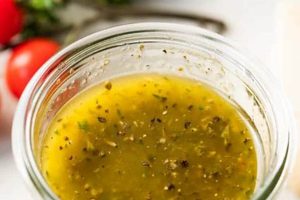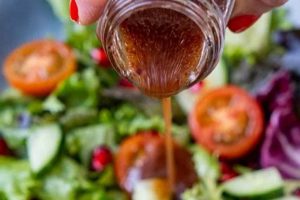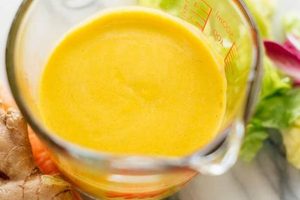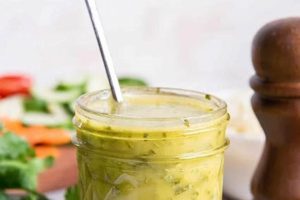A vinaigrette is an emulsion of oil and an acid, typically vinegar, often flavored with herbs, spices, or other ingredients. It serves as a simple yet versatile dressing for salads, vegetables, and even some protein dishes. A basic version might involve whisking together three parts oil to one part vinegar, seasoned with salt and pepper. More complex versions can incorporate Dijon mustard, honey, maple syrup, or various aromatic ingredients.
Vinaigrettes offer a lighter, healthier alternative to creamy dressings. Their tartness brightens flavors, while the oil provides a richness that coats ingredients without overwhelming them. Dating back centuries, vinaigrette’s enduring popularity stems from its ease of preparation, adaptability, and fresh, vibrant character. From a simple balsamic vinaigrette to a complex herb-infused creation, it provides a customizable culinary foundation.
This exploration will delve into the essential components of successful vinaigrette preparation, discuss the diverse range of ingredients that can be utilized, and offer various recipes, from classic to contemporary.
Tips for Crafting Exceptional Vinaigrettes
Creating a balanced and flavorful vinaigrette involves understanding the interplay of ingredients and techniques. These tips offer guidance for achieving optimal results.
Tip 1: Quality Ingredients Matter: The foundation of a delicious vinaigrette lies in using high-quality oil and vinegar. Extra virgin olive oil provides a robust flavor, while other oils like avocado or grapeseed offer milder alternatives. Experiment with different vinegars, such as balsamic, red wine, or apple cider, to discover preferred flavor profiles.
Tip 2: Balance is Key: The standard ratio of three parts oil to one part vinegar offers a good starting point. However, palates vary, so adjustments might be necessary to achieve the desired balance of tartness and richness.
Tip 3: Emulsification is Crucial: Proper emulsification prevents the vinaigrette from separating, ensuring a cohesive texture. Whisk the ingredients vigorously or use a blender to create a stable emulsion.
Tip 4: Seasoning Enhances Flavor: Salt and freshly ground black pepper are essential seasonings. A pinch of sugar or a touch of honey can balance the acidity and enhance overall flavor complexity.
Tip 5: Fresh Herbs and Spices Elevate the Profile: Incorporating fresh herbs, such as chives, parsley, or thyme, or adding spices like garlic powder or paprika, can significantly enhance the vinaigrette’s aroma and taste.
Tip 6: Taste and Adjust: Tasting the vinaigrette throughout the preparation process allows for adjustments to be made as needed. This ensures the final product aligns with individual preferences.
Tip 7: Storage Considerations: Store leftover vinaigrette in an airtight container in the refrigerator for up to a week. Shake well before using, as some separation may occur over time.
By following these guidelines, one can consistently produce vinaigrettes that elevate salads and other dishes. Mastering the art of vinaigrette preparation opens up a world of culinary possibilities.
This understanding of technique and ingredient selection allows for the creation of vinaigrettes perfectly tailored to individual tastes and specific culinary applications. The following section will offer several recipes to further illustrate these principles.
1. Ingredients
Ingredients form the foundation of any vinaigrette, directly impacting its flavor, texture, and overall quality. A basic vinaigrette comprises oil, vinegar, and seasoning. However, the nuanced selection of each ingredient dramatically influences the final product. The type of oil contributes significantly to the taste and mouthfeel. For example, extra virgin olive oil imparts a peppery, robust flavor, while avocado oil offers a smoother, more neutral profile. Similarly, the choice of vinegar plays a crucial role. Balsamic vinegar adds a sweet, tangy complexity, whereas red wine vinegar provides a sharper, more acidic note. The quality of these core ingredients is paramount; fresh, high-quality components yield superior results.
Beyond the foundational elements, additional ingredients offer opportunities for customization and complexity. Fresh herbs, such as dill, mint, or tarragon, introduce aromatic dimensions and enhance the vinaigrette’s freshness. Spices, including garlic powder, onion powder, or smoked paprika, contribute depth and warmth. Other additions, like honey, maple syrup, or Dijon mustard, further modify the flavor profile and texture, creating a wider range of possibilities. Consider the interplay of these ingredients; a vinaigrette with strong-flavored additions may require adjustments to the oil and vinegar proportions to maintain balance.
Understanding the impact of individual ingredients enables the creation of vinaigrettes tailored to specific culinary applications. A light and herbaceous vinaigrette complements delicate greens, while a robust, garlic-infused version might better suit a heartier salad or grilled vegetables. Careful ingredient selection is essential for crafting a successful vinaigrette that enhances, rather than overpowers, the accompanying dish. The interplay of flavors, textures, and aromas, stemming directly from the chosen ingredients, dictates the ultimate success of the vinaigrette.
2. Proportions
Proportions are fundamental to a successful vinaigrette, dictating the balance between oil and vinegar, and influencing the final flavor profile and texture. The standard ratiothree parts oil to one part vinegarserves as a reliable starting point, but achieving the ideal balance often requires adjustments based on the specific ingredients and desired outcome. Understanding the impact of proportions allows for precise control over the vinaigrette’s character, ensuring it complements rather than overwhelms the accompanying dish.
- Oil-to-Vinegar Ratio
This ratio forms the core of a vinaigrette’s structure. A higher oil proportion yields a richer, milder dressing, while a higher vinegar proportion results in a sharper, more acidic taste. Adjusting this ratio allows customization based on personal preference and the specific ingredients used. For instance, a robust balsamic vinegar might require a higher oil ratio to balance its intensity, whereas a milder apple cider vinegar could accommodate a lower oil proportion. This dynamic interplay between oil and vinegar underscores the importance of precise measurement and adjustment.
- Emulsifier Concentration
Emulsifiers, such as Dijon mustard or honey, help bind the oil and vinegar, creating a stable and homogenous mixture. The amount of emulsifier used affects the vinaigrette’s texture and stability. Too little emulsifier can result in a quick separation, while too much can create an overly thick or viscous consistency. Finding the right balance ensures a smooth, well-integrated dressing that clings appropriately to the salad ingredients without being heavy or gloppy. The type of emulsifier used also influences the final flavor profile; Dijon adds a subtle tang, while honey contributes sweetness.
- Additional Ingredient Quantities
Incorporating additional ingredients, such as herbs, spices, or sweeteners, adds complexity and depth to the vinaigrette. However, the quantities of these additions must be carefully considered. Overuse can lead to an unbalanced or overpowering flavor profile, masking the delicate flavors of the salad itself. Starting with small amounts and gradually adjusting based on taste testing allows for precision and control, ensuring the added ingredients enhance rather than dominate the overall composition.
- Scaling for Quantity
The ability to accurately scale vinaigrette proportions is essential when preparing dressings for varying serving sizes. Whether preparing a small vinaigrette for a single serving or a larger batch for a gathering, maintaining the correct ratios of all ingredients ensures consistent flavor and texture. Precise measurement and calculation are crucial in scaling recipes effectively.
Mastery of proportions is essential for crafting vinaigrettes that are well-balanced, flavorful, and perfectly suited to their intended purpose. By understanding the interplay of oil, vinegar, emulsifiers, and additional ingredients, one can create vinaigrettes that elevate any salad, enhancing its flavors and providing a harmonious culinary experience.
3. Emulsification
Emulsification is crucial for creating a stable and homogenous vinaigrette. It involves combining two immiscible liquidsoil and vinegarinto a uniform mixture that resists separation. Without proper emulsification, the vinaigrette will quickly separate back into its constituent parts, resulting in an uneven distribution of flavor and a less appealing texture. This section explores the key facets of emulsification in vinaigrette preparation.
- Temporary vs. Permanent Emulsions
Vinaigrettes are typically temporary emulsions, meaning they will eventually separate. Permanent emulsions, like mayonnaise, utilize ingredients like egg yolks that create a more stable, long-lasting bond. While a temporary emulsion is acceptable for most vinaigrettes, understanding the factors that influence stability allows for greater control over the final product.
- The Role of Emulsifiers
Emulsifiers contain both hydrophilic (water-loving) and lipophilic (oil-loving) components, allowing them to bridge the gap between oil and vinegar molecules. Common emulsifiers in vinaigrettes include Dijon mustard, honey, and egg yolks (for more permanent emulsions). These ingredients coat the oil droplets, preventing them from coalescing and maintaining a smooth, evenly distributed mixture.
- Techniques for Emulsification
Effective emulsification requires mechanical force to break down the oil into smaller droplets and disperse them evenly throughout the vinegar. Whisking vigorously by hand creates a temporary emulsion, while using a blender or food processor generates a finer, more stable emulsion. The choice of technique depends on the desired texture and available equipment.
- Factors Affecting Stability
Several factors influence emulsion stability. Temperature plays a significant role; extreme temperatures can destabilize the emulsion. The ratio of oil to vinegar also affects stability; a higher oil content generally leads to a more stable emulsion. Additionally, the presence of impurities or solids in the ingredients can disrupt the emulsion, highlighting the importance of using fresh, high-quality components.
A well-emulsified vinaigrette contributes significantly to the sensory experience of a salad. It provides a smooth, cohesive texture and ensures an even distribution of flavor across all ingredients. By understanding the principles of emulsification and employing appropriate techniques, one can consistently create vinaigrettes that enhance the overall dining experience.
4. Flavor Balance
Flavor balance is paramount in a successful vinaigrette. It represents the harmonious interplay of sweet, sour, salty, and sometimes bitter or umami notes, creating a unified and pleasing taste experience. A well-balanced vinaigrette enhances the flavors of the salad ingredients without overpowering them. It requires careful consideration of the inherent flavors of the oil and vinegar, along with any additional components such as herbs, spices, or sweeteners. For example, the sharpness of red wine vinegar might be balanced by the sweetness of honey or maple syrup, while the peppery notes of extra virgin olive oil can be complemented by the earthiness of dried herbs.
Achieving flavor balance involves an iterative process of tasting and adjusting. It is crucial to understand how different ingredients interact and influence the overall profile. The inherent acidity of vinegar needs to be balanced by other elements, whether through the addition of sweeteners or the careful selection of a milder oil. Similarly, the intensity of certain herbs or spices should be tempered to prevent them from dominating the flavor profile. Consider a balsamic vinaigrette: the sweetness of the balsamic vinegar may require less added sweetener than a vinaigrette using a sharper vinegar like apple cider. This highlights the importance of considering the individual characteristics of each ingredient and adjusting proportions accordingly. Practical application involves tasting the vinaigrette throughout the preparation process, making incremental adjustments until the desired balance is achieved.
A well-balanced vinaigrette elevates a salad from a simple combination of ingredients to a cohesive and satisfying culinary experience. The balance of flavors ensures that no single element dominates, allowing the individual flavors of the salad components to shine while simultaneously being enhanced by the vinaigrette. Failure to achieve this balance can lead to a vinaigrette that is overly acidic, excessively sweet, or dominated by a single flavor note, detracting from the overall enjoyment of the dish. Therefore, mastering flavor balance is an essential skill for anyone seeking to create exceptional vinaigrettes.
5. Customization
Customization lies at the heart of vinaigrette versatility. A basic recipe provides a foundational framework, but the true potential of a vinaigrette emerges through the adaptation of ingredients and proportions to suit individual preferences and specific culinary applications. This inherent adaptability distinguishes vinaigrettes from other dressings, offering cooks a creative platform to experiment with flavors and textures. Customization allows for the creation of vinaigrettes that perfectly complement a wide range of salads, from delicate greens to heartier compositions. For instance, a simple vinaigrette of olive oil, red wine vinegar, and Dijon mustard can be transformed with the addition of fresh herbs like tarragon or thyme, or by incorporating spices such as smoked paprika or cumin. The possibilities are vast, limited only by the cook’s imagination and the desired flavor profile.
The practical significance of customization extends beyond simply adjusting flavors. It empowers cooks to accommodate dietary restrictions and preferences. A vegan vinaigrette, for example, might substitute maple syrup for honey, while those avoiding gluten can opt for a gluten-free mustard. Customization also allows for seasonal adaptations; a summer vinaigrette might feature fresh basil and mint, while a winter version could incorporate roasted garlic or dried cranberries. This flexibility makes vinaigrettes an ideal choice for year-round enjoyment. Furthermore, customization allows for creative exploration and the development of unique flavor profiles. A chef might develop a signature vinaigrette featuring local ingredients or an unusual spice blend, demonstrating the potential of vinaigrettes as a canvas for culinary expression.
Customization is integral to the enduring appeal of vinaigrettes. It transforms a simple recipe into a versatile tool for culinary exploration, allowing for the creation of dressings perfectly tailored to individual tastes and specific dishes. This adaptability, combined with the inherent simplicity of the basic formula, solidifies the vinaigrette’s position as a staple in kitchens worldwide. Understanding the principles of customization empowers cooks to move beyond pre-made dressings and embrace the creative potential of crafting their own unique vinaigrettes.
6. Application
The application of a vinaigrette extends far beyond simply drizzling it over a bed of lettuce. Understanding the nuances of applicationconsidering the type of salad, the ingredients within the salad, and the desired flavor profileelevates the dish from simple to sophisticated. A thoughtfully applied vinaigrette enhances the overall dining experience, unifying flavors and textures, and providing a cohesive culinary narrative.
- Matching Vinaigrette to Salad Type
Different salads require different vinaigrettes. A delicate salad of spring greens benefits from a light, bright vinaigrette, perhaps one with a citrus or herb focus. Conversely, a robust salad with roasted vegetables or grilled meats might require a more assertive vinaigrette, possibly incorporating bolder flavors like Dijon mustard, roasted garlic, or smoked paprika. The vinaigrette should complement, not overpower, the inherent flavors of the salad ingredients. A mismatch can lead to a disjointed and unbalanced culinary experience.
- Ingredient Compatibility
The ingredients within a salad significantly influence vinaigrette selection. Consider the presence of fruits, cheeses, nuts, or proteins. A vinaigrette with a sweet element, such as honey or maple syrup, might pair well with a salad containing fruit, while a tangy vinaigrette with crumbled blue cheese could complement a salad featuring walnuts and pears. The goal is to create a harmonious interplay of flavors, where the vinaigrette enhances the existing ingredients without creating clashes or imbalances.
- Amount and Timing of Application
The amount of vinaigrette applied and the timing of its application also impact the final result. Too much vinaigrette can overwhelm the salad, making it soggy and heavy. Too little can leave the salad dry and under-seasoned. The ideal amount lightly coats the ingredients without drowning them. Furthermore, the timing of application is critical, especially for delicate greens. Adding the vinaigrette too early can cause the greens to wilt. For optimal results, dress the salad just before serving, ensuring the ingredients remain crisp and vibrant.
- Beyond Salads: Exploring Alternative Applications
While salads are the most common application for vinaigrettes, their versatility extends beyond leafy greens. Vinaigrettes can serve as marinades for meats, poultry, or fish, adding flavor and tenderizing the protein. They can also be used as a sauce for roasted vegetables, adding brightness and complexity. Even simple steamed vegetables benefit from a drizzle of vinaigrette, elevating their flavor profile. Exploring these alternative applications highlights the true potential of vinaigrettes as a versatile culinary tool.
Mastering the application of vinaigrettes is essential for maximizing their culinary potential. By considering the type of salad, the compatibility of ingredients, and the timing and amount of application, one can create dishes that are not only flavorful but also visually appealing and texturally satisfying. Furthermore, exploring alternative applications beyond salads expands the possibilities, demonstrating the versatility of vinaigrettes and their ability to enhance a wide array of dishes. A well-applied vinaigrette transforms a simple salad or dish into a cohesive and memorable culinary creation.
Frequently Asked Questions
This section addresses common inquiries regarding vinaigrette preparation, offering practical solutions and clarifying potential misconceptions.
Question 1: How can one prevent vinaigrette from separating?
Vigorous whisking creates a temporary emulsion, but for increased stability, an emulsifier like Dijon mustard or honey is recommended. These ingredients help bind the oil and vinegar, preventing separation. Alternatively, a blender or food processor creates a more stable emulsion.
Question 2: What is the ideal oil-to-vinegar ratio?
A 3:1 ratio of oil to vinegar is standard, but individual preferences and ingredient characteristics influence the optimal balance. A milder vinegar may allow for a lower oil ratio, while a more robust vinegar might benefit from a higher proportion of oil.
Question 3: Can vinaigrettes be made ahead of time?
Vinaigrettes can be prepared in advance and stored in an airtight container in the refrigerator for up to a week. However, some separation may occur, so re-whisking or shaking before serving is advisable.
Question 4: What can be substituted for vinegar in a vinaigrette?
While vinegar is traditional, other acidic ingredients like lemon or lime juice can be substituted. These alternatives offer unique flavor profiles and can be particularly suitable for specific salads or dishes.
Question 5: How can one adjust a vinaigrette that is too acidic?
A touch of sweetness, such as honey, maple syrup, or a pinch of sugar, can balance excessive acidity. Alternatively, adding more oil can also mitigate sharpness.
Question 6: Are all vinaigrettes suitable for all types of salads?
No, the vinaigrette should complement the salad’s ingredients. A delicate vinaigrette suits lighter greens, while a more robust vinaigrette pairs well with heartier salads or roasted vegetables.
Understanding these fundamental aspects of vinaigrette preparation empowers one to create flavorful, well-balanced dressings tailored to individual preferences and specific culinary needs.
This comprehensive guide to vinaigrette preparation equips readers with the knowledge and techniques necessary to elevate their salads and explore the vast potential of this versatile dressing. Experimentation with various ingredients and proportions is encouraged, fostering culinary creativity and personalized flavor experiences.
Recipe for Vinaigrette Dressing for Salad
Exploration of vinaigrette recipes reveals a deceptively simple dressing with vast culinary potential. From ingredient selection and proportioning to emulsification and flavor balancing, each step contributes significantly to the final product. Customization, informed by an understanding of these core principles, allows adaptation to diverse palates and specific culinary applications. Furthermore, proper application, considering the interplay of vinaigrette and salad composition, elevates the dining experience.
Mastery of vinaigrette preparation offers a pathway to culinary creativity and personalized flavor experiences. Exploration beyond basic recipes unlocks a world of possibilities, transforming simple salads into sophisticated culinary expressions. Continued experimentation and refinement of technique promise rewarding results for both novice and experienced cooks alike.






